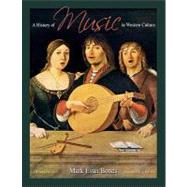
Note: Supplemental materials are not guaranteed with Rental or Used book purchases.
Purchase Benefits
What is included with this book?
| Preface | |
| Prologue: Antiquity Music in the Biblical World Ancient | |
| Greece Music in Ancient Greek Society | |
| Greek Musical Theory Music in the Roman Empire | |
| The Musical Legacies of Antiquity Music and the Cosmos Music and the Soul Music and the State | |
| Theory versus Practice Vocal versus | |
| Instrumental Music | |
| Discussion | |
| Questions | |
| The Medieval Era Prelude to Part I | |
| Plainchant and Secular Monophony | |
| The Emergence of Plainchant | |
| The Elements of Plainchant Liturgical Function Relationship of Words and Music Mode Melodic Structure Rhythm | |
| The Expansion of Plainchant Secular Monophony Songs in Latin France | |
| The Iberian Peninsula Germany | |
| Polyphony to 1300 Orgunum Innovations in Organum Notre Dame Organum Clausula Motet Conductus | |
| Mensural Notation Franconian Notation | |
| Petronian Notation | |
| Music in the 14th Century France: The Ars Nova Le Roman de Fauvel Polyphonic Settings of the Mass Ordinary Secular Song | |
| The Ars subtilior at the End of the 14th Century Italy: The Trecento England Instrumental Music | |
| Discussion | |
| Questions | |
| The Renaissance Prelude to Part II | |
| Renaissance Humanism | |
| The Protestant Reformation Renaissance | |
| Painting and Sculpture Music in Renaissance Society | |
| The Emergence of Renaissance Style | |
| Consonance and Dissonance: Trusting the Ear | |
| Sonority: The Contenance Angloise Fauxbourdon and Faburden New Sonority | |
| Old Structure: Du Fayrsquo;s Nuper rosarum flores Josquinrsquo;s Ave Maria | |
| Virgo Serena and The Style of the Renaissance Treatment of Text Texture | |
| Cadential Structure Mode Melody Rhythm Harmony | |
| The Genres of Renaissance Music, 1420-1520 Sacred Vocal Music | |
| The Mass: Du Fay and Ockeghem The Mass: Josquin des Prez and His What is included with this book? The New copy of this book will include any supplemental materials advertised. Please check the title of the book to determine if it should include any access cards, study guides, lab manuals, CDs, etc. The Used, Rental and eBook copies of this book are not guaranteed to include any supplemental materials. Typically, only the book itself is included. This is true even if the title states it includes any access cards, study guides, lab manuals, CDs, etc. Rewards Program |